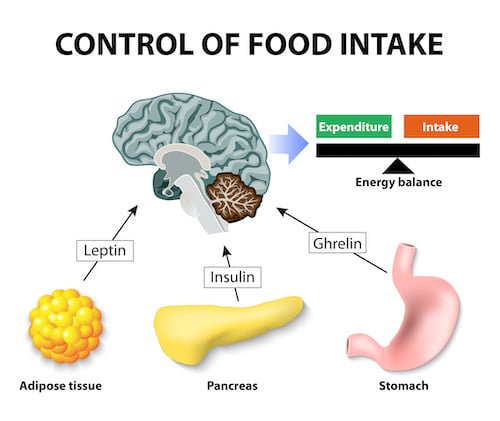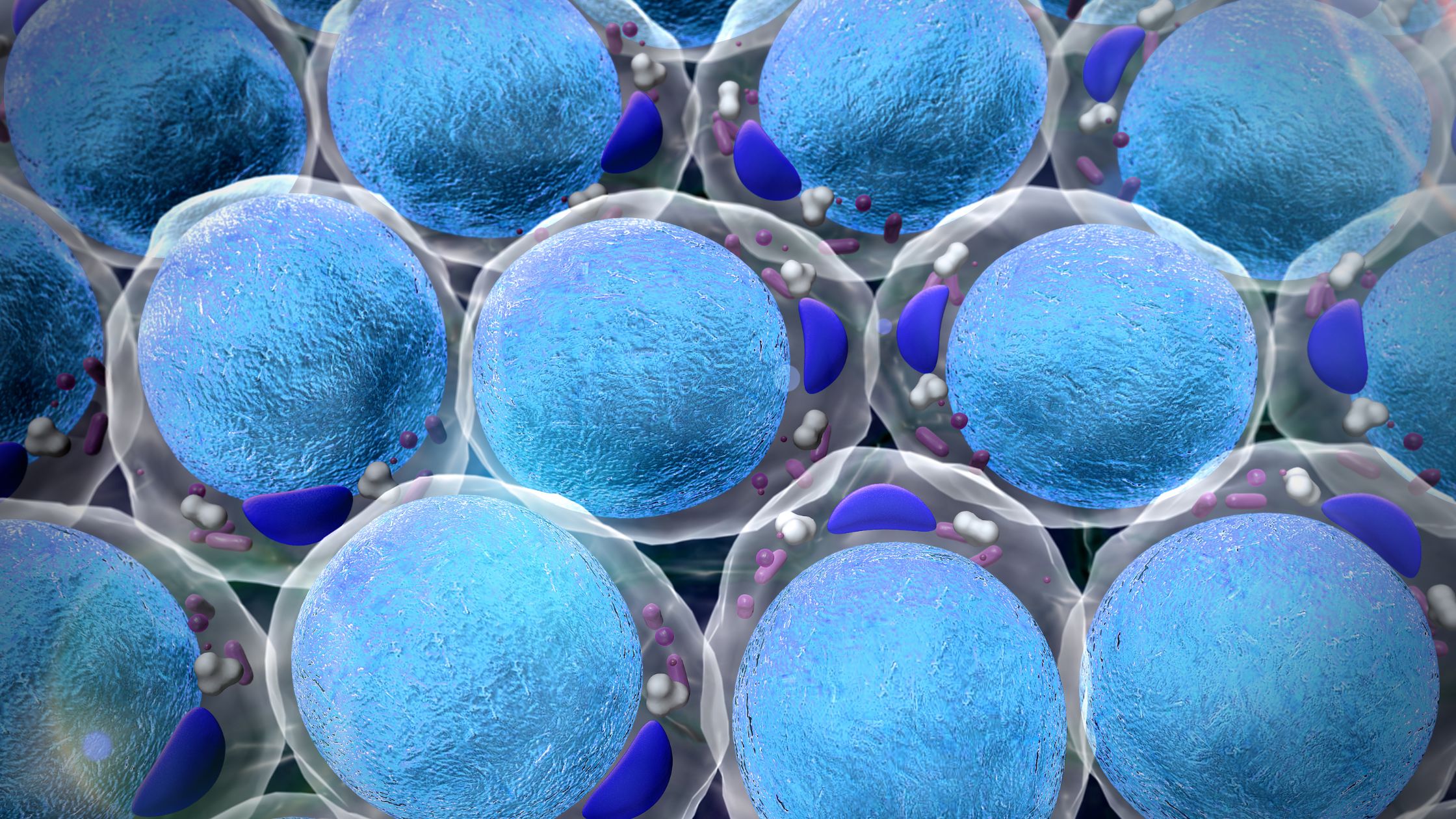A Guide To Leptin And Fat Regulation
You may have heard that leptin controls your hunger – but how? In a good way or bad way? And what is leptin resistance? Health and fitness expert Ben Hardman helps break down what science and research have taught us so far…
Have you ever thought about feeling hungry and full? I’m sure you have. My feelings are usually in the hungry camp!
But I mean really thought about it?
These everyday thoughts are a clever trick from your brain to help you maintain a consistent body weight. These feelings, and the mechanisms behind them, are integral to weight management.
Of course it’s to do with the food you eat and how long you leave between meals, but things go deeper than this.
There are feedback loops at play, hormones floating around your bloodstream, and messages being sent up and down your central nervous system. It’s complex stuff.
A key hormone helping to regulate these feelings is leptin.
The presence of leptin in your blood tells your brain that you’re full. You’ve had enough. But, as you’ll find out, the feedback pathways don’t always work as they should.
And for this reason, there’s a strong link between consistently high leptin levels and unhealthy body weight.
So, let’s jump into all you need to know about leptin.
What Is Leptin?
Leptin is a peptide hormone secreted by fat cells in our body.
It’s known as the ‘satiety hormone’ for the role it plays in making you feel like you don’t need any more food.

The aim of leptin is to help regulate food intake and overall energy status. No small job then.
It’s a relatively recent discovery, first identified in 1994 by molecular geneticist Jeffrey Friedman after his intense research on obese mice.
Friedman managed to isolate the obese gene and realised that it produced a hormone he called leptin. In the obese mice, this gene (and its product leptin) was defected, resulting in massive weight gain.
Since then almost 30,000 articles have been published on leptin. This tells you all you need to know about leptin’s importance.
Leptin is often seen as the opposite to ghrelin ─ the so-called hunger hormone.
Importantly, these two hormones act together in a push and pull mechanism. This is much in the same way that opposite muscle pairings work ─ your biceps and triceps are antagonistic but work together to move your arm.
This is what leptin and ghrelin do to control food intake and energy balance.
How Is Leptin Made?
This is where it gets interesting.
Leptin is synthesised by white adipose tissue. You’ll know these are white fat cells.
Usually it’s glands that release hormones, but thanks to Friedman’s discovery, this means that fat is actually an endocrine organ too.
It was found that the amount of leptin released into the blood is directly related to the amount of fat mass in the body.

The short rule of thumb is this:
- Higher levels of fat mass = more leptin
- Lower levels of fat mass = less leptin
Simple, isn’t it? If only this was the case.
Although fat levels are the direct proportional link, leptin may be influenced by other factors in the grand scheme of things.
Factors such as calorie intake, food timings, sleep quality, stress and exercise may have some form of influence further down the stream.
Leptin secretion can also be stimulated by the stomach as it digests food ─ this is the message saying you’ve got enough calories and fat reserves for your energy needs, so put the fork down!
Due to the high palatability of some foods, this doesn’t always happen.
What Role Does Leptin Play In The Body?
Leptin has a number of neuroendocrine functions. These are jobs that involve the interaction of your central nervous system with your hormone synthesis and distribution channels.
Taking a zoomed-out view on the subject, leptin’s main role is to regulate fat tissue mass.
Why, you may ask?
It’s all to do with energy balance within our bodies. Did you know that around 80% of the body’s energy reserves are stored in fats?
Going back to the early human days, your brain needed to make sure the body had enough energy reserves to go about its necessary business ─ living, surviving and reproducing.
Leptin helps to go about its main fat regulation role by influencing a number of secondary factors. These include appetite levels, motivation and feeding behaviours.
As the accumulation or loss of fat tends to be gradual (no, it can’t be lost overnight), leptin serves its function of energy balance over the long term.
That said, leptin also plays a significant role in controlling hunger and metabolism in a more short-term context. It does this through an inverse feedback loop, as you’ll find out just below.
As well as energy balance, leptin plays important roles in reproduction, puberty and immune system functioning.
How Do Leptin Levels Work?
So you now know that leptin levels are directly linked to fat mass, the body’s main store of energy reserves.
There are leptin receptors present around the body ready to detect (or not detect) leptin levels. These are located in the brain and in cells of the pancreas, liver, heart and intestines.
There are two primary feedback loops at play:
- Higher levels of fat mass lead to the release of more leptin, telling your body you don’t need any more food.
- Lower levels of fat mass result in less leptin being released. Your brain interprets this as you’re in an energy deficit and need to eat more. This perceived energy shortage triggers a cascade of responses so the body can cope with this state of so-called starvation.
This simple system of back and forth is what maintains control of adipose tissue mass, and therefore general body weight, over the long term.
It’s a homeostatic mechanism in that the body wants to reach a stable equilibrium.
You do have natural daily cycles of leptin too. These help to control dietary urges.
For example, leptin levels are increased between the sleeping hours of midnight and dawn, so you don’t get any cravings whilst your body is resting.
What Is Leptin Resistance?
Sometimes the system gets it wrong. It gets worn down and ends up breaking.
When this happens, your brain ends up not sending messages to say you’re full, even when you already have adequate fat levels and plenty of energy in reserve.
Here, your brain isn’t responding to leptin properly. The body has developed leptin resistance.
This isn’t good as it leads to overeating and excess fat storage. How does the body get to this point?
In very rare cases, it’s caused by a genetic mutation to leptin or leptin receptors.
However, the main cause of leptin resistance is through chronically elevated leptin levels across a long period of time. It’s a lifestyle problem. It’s the same way that type 2 diabetes occurs.
The main drivers of leptin resistance are diets that are:
- High in fat
- High in carbohydrates
- High in fructose and sucrose
- Low in protein
It’s thought that highly processed foods that are desirable and moreish can impact neural pathways controlling calorie intake. They have knock-on effects on the pathways controlling leptin and ghrelin. The result is you want to eat more of them!
When leptin is constantly present in the blood because of high fat mass levels, the body becomes accustomed to it. The constant messages eventually break the system and the correct signals no longer get sent.
The result is further fat gains and a road to obesity.
Can Leptin Be Used To Encourage Weight Loss?
To quickly recap: leptin plays a crucial role in regulating fat mass levels. Higher leptin levels should result in your appetite being suppressed – increasing leptin levels is something that a good appetite suppressant should look to target.
Does this mean that leptin can be used as some form of weight loss supplement then? Take leptin and you won’t feel as hungry?
Yes and no.
Leptin hormone therapy is a thing. Studies have shown that leptin therapy for people with genetic leptin mutations, or who don’t produce leptin at all, can be successful.
The main problem is that most obese people don’t have a lack of leptin ─ they have too much of it!
It’s just that their bodies are failing to respond to it properly, as we’ve just seen with leptin resistance. In this case, leptin therapy won’t make the slightest bit of difference.
Unfortunately, there isn’t an easy fix to overcome leptin resistance. The main route to try and bring leptin sensitivity back is to make significant lifestyle changes when it comes to diet and exercise.
A good place to start is with the opposites of the leptin resistance drivers ─ a diet low in fat, carbs and refined sugars, plus high levels of protein.
Eating a good, healthy diet means your neural pathways controlling impulse and calorie intake aren’t short-circuited. Unprocessed, natural, whole foods are fantastic options for good appetite regulation.
If you end up on a clean, low-calorie diet, your body should start to lose fat mass. Some people may also choose to use fat burners to assist with this. As leptin levels are directly linked to fat mass, the hope is that your body can regain a measure of homeostasis again and that leptin sensitivity will come back into play.
There’s still lots to discover about leptin and plenty of research still to be done on this hunger controlling hormone.
Sources
https://pubmed.ncbi.nlm.nih.gov/22249808/
https://www.ncbi.nlm.nih.gov/books/NBK537038/
https://www.ncbi.nlm.nih.gov/pmc/articles/PMC8651558/








